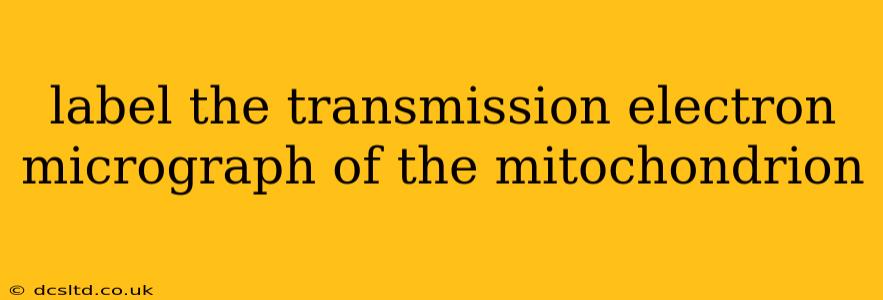Mitochondria, often dubbed the "powerhouses" of the cell, are vital organelles responsible for generating adenosine triphosphate (ATP), the cell's primary energy currency. Understanding their complex structure is key to grasping their function. This guide will walk you through labeling a transmission electron micrograph (TEM) of a mitochondrion, explaining the key features you'll encounter.
What is a Transmission Electron Micrograph (TEM)?
A TEM uses a beam of electrons to visualize the ultrastructure of biological samples. Unlike light microscopy, TEM offers significantly higher resolution, allowing us to see organelles like mitochondria in exquisite detail. The resulting image, a TEM, shows a two-dimensional representation of a thinly sliced sample.
Key Structures to Identify in a Mitochondrion TEM:
Here's a breakdown of the essential components you should be able to label in a typical TEM image of a mitochondrion:
1. Outer Mitochondrial Membrane:
This is the smooth, outer boundary of the mitochondrion. It's relatively permeable due to the presence of porins, protein channels that allow the passage of small molecules. In a TEM, it appears as a thin, dark line.
2. Inner Mitochondrial Membrane:
This membrane is highly folded, forming structures called cristae. These folds significantly increase the surface area available for ATP production. The inner membrane is selectively permeable and plays a critical role in the electron transport chain and oxidative phosphorylation. In a TEM, it appears as a series of invaginations or folds within the mitochondrion.
3. Cristae:
These are the characteristic inward folds of the inner mitochondrial membrane. Their folded nature is crucial for maximizing the efficiency of ATP synthesis. They appear as shelf-like or finger-like projections within the inner membrane space in a TEM.
4. Intermembrane Space:
This is the narrow region between the outer and inner mitochondrial membranes. It's a crucial compartment for maintaining the proton gradient vital for ATP synthesis. In a TEM, it appears as a relatively clear space between the two membranes.
5. Mitochondrial Matrix:
This is the innermost compartment of the mitochondrion, enclosed by the inner membrane. It contains mitochondrial DNA (mtDNA), ribosomes, and enzymes involved in the Krebs cycle (citric acid cycle) and other metabolic pathways. In a TEM, it appears as a granular or electron-dense region within the inner membrane.
Frequently Asked Questions (FAQs):
What is the function of the cristae?
The cristae significantly increase the surface area of the inner mitochondrial membrane, providing ample space for the protein complexes involved in the electron transport chain and oxidative phosphorylation. This increased surface area maximizes ATP production.
What is found in the mitochondrial matrix?
The mitochondrial matrix contains the mitochondrial DNA (mtDNA), ribosomes (for protein synthesis), and numerous enzymes involved in essential metabolic processes such as the Krebs cycle (citric acid cycle), fatty acid oxidation, and amino acid metabolism.
How does the inner mitochondrial membrane differ from the outer mitochondrial membrane?
The outer mitochondrial membrane is relatively permeable due to the presence of porins, while the inner mitochondrial membrane is highly impermeable, regulating the passage of molecules and ions. This selective permeability is crucial for maintaining the proton gradient necessary for ATP synthesis.
What is the role of the intermembrane space?
The intermembrane space plays a critical role in chemiosmosis, the process that drives ATP synthesis. The proton gradient established across the inner membrane is crucial for this process. Protons are pumped into this space during the electron transport chain.
How can I improve my ability to identify these structures in a TEM?
Practice! Examine multiple TEMs of mitochondria, and refer to labeled diagrams or atlases. Pay close attention to the relative positions and appearances of the different structures. The more images you analyze, the easier it will become to identify each component.
By carefully studying TEM images and understanding the functions of each component, you'll gain a deep understanding of the mitochondrion’s intricate structure and its critical role in cellular energy production. Remember that the appearance of a mitochondrion in a TEM may vary slightly depending on the preparation technique and the cell type from which it originates. However, the fundamental features described above will always be present.
